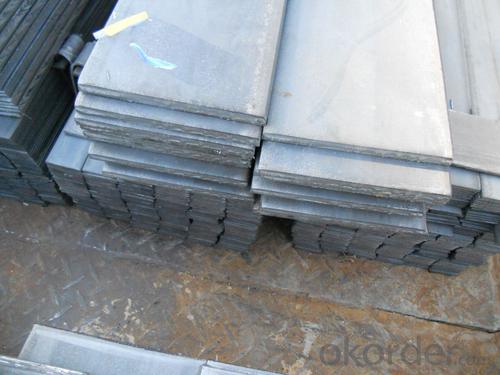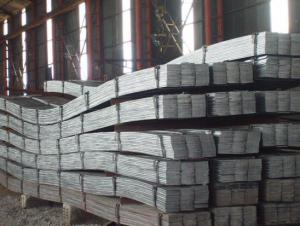Hot Rolled Flat Bar in Q235B with High Quality
- Loading Port:
- Tianjin
- Payment Terms:
- TT OR LC
- Min Order Qty:
- 25 m.t.
- Supply Capability:
- 10000 m.t./month
OKorder Service Pledge
OKorder Financial Service
You Might Also Like
Product Description:
OKorder is offering high quality Slit Cutting Flat Bar at great prices with worldwide shipping. Our supplier is a world-class manufacturer of steel, with our products utilized the world over. OKorder annually supplies products to European, North American and Asian markets. We provide quotations within 24 hours of receiving an inquiry and guarantee competitive prices.
Product Applications:
Slit Cutting Flat Bars are ideal for structural applications and are widely used in the construction of buildings and bridges, and the manufacturing, petrochemical, and transportation industries.
Product Advantages:
OKorder's Slit Cutting Flats Barare durable, strong, and resist corrosion.
Main Product Features:
· Premium quality
· Prompt delivery & seaworthy packing (30 days after receiving deposit)
· Corrosion resistance
· Can be recycled and reused
· Mill test certification
· Professional Service
· Competitive pricing
Product Specifications:
Manufacture: Slit Cutting
Grade: Q195 – 235
Certificates: ISO, SGS, BV, CIQ
Length: 6m – 12m, as per customer request
Packaging: Export packing, nude packing, bundled
Chemical composition of Q235
Alloy No | Grade | Element(%) | ||||
C
| Mn
| S
| P
| Si
| ||
Q235
|
B
|
0.12—0.20 |
0.3—0.7 |
≤0.045 |
≤0.045
|
≤0.3
|
Physical properties of Q235
Alloy No | Grade | Yielding strength point(Mpa) | Tensile strength (Mpa) | Elongation after fracture(%) | ||||||
Thickness (mm) | Thickness (mm) | |||||||||
≤16 | >16--40 | >40--60 | >60--100 | ≤16 | >16--40 | >40--60 | >60--100 | |||
≥ | ≥ | |||||||||
Q235 |
B |
235 |
225 |
215 |
205 |
375--500 |
26 |
25 |
24 |
23 |
FAQ:
Q1: How soon can we receive the product after purchase?
A1: Within three days of placing an order, we will begin production. The specific shipping date is dependent upon international and government factors, but is typically 7 to 10 workdays.
Q2: How do we guarantee the quality of our products?
A2: We have established an advanced quality management system which conducts strict quality tests at every step, from raw materials to the final product. At the same time, we provide extensive follow-up service assurances as required.
Q3: The products are invoicing on theoritical weight or on actual weight?
A3: We can do it in both manners, according to the customers' request.
Images:


- Q: What are the different types of surface defects in stainless steel flat bars?
- Stainless steel flat bars can exhibit various types of surface defects, which can be classified into several categories. Some common surface defects in stainless steel flat bars include: 1. Pitting: Pitting is the formation of small, localized corrosion spots on the surface of stainless steel flat bars. It appears as small holes or pits and is usually caused by exposure to aggressive environments such as chloride-containing solutions or acidic substances. 2. Scaling: Scaling is the formation of oxide layers on the surface of stainless steel flat bars due to high-temperature exposure. It appears as a flaky or powdery deposit and can result from processes like heat treatment or welding. 3. Corrosion: Corrosion refers to the gradual deterioration of the stainless steel surface due to chemical reactions with the environment. It can occur in various forms, including uniform corrosion, crevice corrosion, or stress corrosion cracking, depending on the specific conditions and environment. 4. Scratches: Scratches are physical marks on the surface of stainless steel flat bars caused by abrasive contact or mechanical damage. They can vary in depth and severity, and if not properly addressed, they can create localized areas of stress concentration and potential sites for further corrosion. 5. Roll marks: Roll marks are surface imperfections that occur during the manufacturing process of stainless steel flat bars. They appear as irregular patterns or lines on the surface and are typically caused by the rolling or finishing equipment used in production. 6. Discoloration: Discoloration refers to the change in the appearance or color of the stainless steel flat bar surface. It can be caused by exposure to high temperatures, chemical reactions, or improper cleaning methods. Discoloration can appear as light or dark patches, streaks, or a rainbow-like effect known as "heat tint" in the case of overheating during welding. It is important to note that surface defects in stainless steel flat bars can not only impact the aesthetic appeal but also compromise the material's corrosion resistance, mechanical properties, and overall performance. Therefore, it is crucial to identify, assess, and address any surface defects promptly to ensure the longevity and reliability of stainless steel flat bars.
- Q: What is the cost of steel flat bars compared to other materials?
- The cost of steel flat bars is generally lower compared to other materials such as aluminum or stainless steel.
- Q: What type of steel is commonly used for flat bars?
- Flat bars made from mild steel are frequently utilized in construction, manufacturing, and other scenarios where a robust and dependable material is essential. This type of steel, known for its versatility and widespread availability, boasts impressive strength, durability, and ease of machining. Moreover, stainless steel is another steel variant regularly employed for flat bars, especially in situations demanding resistance against corrosion and staining. Consequently, stainless steel flat bars are extensively used in the food industry, architectural projects, and marine applications.
- Q: How do steel flat bars contribute to the energy efficiency of buildings?
- Steel flat bars contribute to the energy efficiency of buildings by providing strong structural support, which helps reduce the need for excessive material usage. This, in turn, minimizes the overall weight of the building, allowing for more efficient use of energy during transportation and construction. Additionally, steel flat bars can be used to create well-insulated frames and components, resulting in improved thermal performance and reduced energy consumption for heating and cooling.
- Q: How do you cut steel flat bars?
- There are multiple ways to cut steel flat bars, depending on the desired precision and available tools. Here, we present three commonly used techniques: 1. Hacksaw: For small projects, using a hacksaw is a basic yet effective method. Start by marking the desired cutting line on the steel bar using a measuring tape and marker. Then, secure the bar in a vice to keep it steady. Take a hacksaw with a bi-metal blade and begin cutting by applying consistent pressure and using long, even strokes. It may require time and effort, but with patience, you can achieve a clean cut. 2. Angle grinder: An angle grinder equipped with a metal cutting disc is a more efficient option for cutting steel flat bars. Prior to starting, ensure your safety by wearing goggles and work gloves. Secure the bar in a vice and mark the cutting line. Next, position the angle grinder perpendicular to the bar and switch it on. Slowly guide the grinder along the marked line, applying moderate pressure. Sparks may occur, so it's important to work in a well-ventilated area and avoid flammable materials. 3. Metal-cutting band saw: If you have access to a metal-cutting band saw, this is the most precise and efficient method. Begin by adjusting the blade tension and aligning the saw's fence with the cutting line on the steel bar. Switch on the saw and gradually feed the bar into the blade, maintaining a steady pace. The band saw's teeth will smoothly cut through the steel, resulting in a clean and accurate cut. Remember to wear safety goggles and gloves when using power tools. Regardless of the chosen cutting method, after the steel flat bar has been cut, it may have sharp edges. To remove any burrs or roughness, employ a file or a metal deburring tool to smooth the edges for a polished appearance.
- Q: Do steel flat bars have a specific grain orientation?
- No, steel flat bars do not have a specific grain orientation. The grains in steel are randomly oriented, resulting in isotropic properties throughout the material.
- Q: How do steel flat bars perform in terms of thermal expansion?
- Steel flat bars have a relatively low coefficient of thermal expansion, which means they expand and contract less than other materials when exposed to changes in temperature. This property makes steel flat bars highly resistant to warping or distorting due to thermal expansion. Additionally, their thermal conductivity is relatively high, allowing for efficient heat transfer. These characteristics make steel flat bars a preferred choice in applications where temperature variations are expected, such as in construction, manufacturing, and engineering projects.
- Q: Can steel flat bars be drilled or tapped easily?
- Drilling or tapping steel flat bars is a breeze. Steel is a versatile material that can be machined using a variety of tools and techniques. To drill holes in steel flat bars, you can use either a drill press or a handheld drill with the appropriate drill bit. Likewise, creating threads in steel flat bars is achievable with a tap and die set. However, the ease of drilling or tapping may vary depending on the thickness and hardness of the steel. Thicker and harder steel bars may require more power and specialized tools for drilling or tapping. Moreover, employing cutting fluids or lubricants can enhance the ease and efficiency of the drilling or tapping process.
- Q: Can steel flat bars be used for making telecommunications industry equipment?
- Yes, steel flat bars can be used for making telecommunications industry equipment. Steel is a versatile and durable material that can provide the necessary strength and stability required for telecommunications equipment. Additionally, steel can also be easily shaped and fabricated to meet specific design requirements, making it suitable for various applications in the telecommunications industry.
- Q: Can steel flat bars be used in the marine industry?
- Yes, steel flat bars can be used in the marine industry. Steel is a commonly used material in maritime applications due to its high strength, durability, and resistance to corrosion. Steel flat bars can be utilized for various purposes such as structural frameworks, support beams, and reinforcement in marine vessels, offshore platforms, and other marine structures. Additionally, steel can be coated or treated to further enhance its resistance to saltwater corrosion, making it suitable for marine environments.
Send your message to us
Hot Rolled Flat Bar in Q235B with High Quality
- Loading Port:
- Tianjin
- Payment Terms:
- TT OR LC
- Min Order Qty:
- 25 m.t.
- Supply Capability:
- 10000 m.t./month
OKorder Service Pledge
OKorder Financial Service
Similar products
Hot products
Hot Searches
Related keywords

























